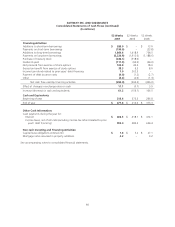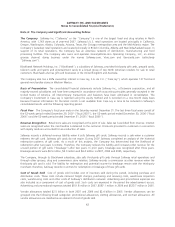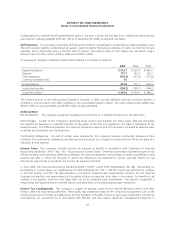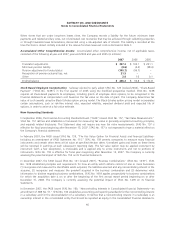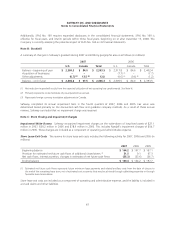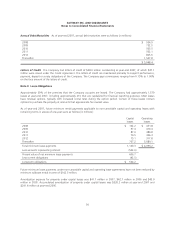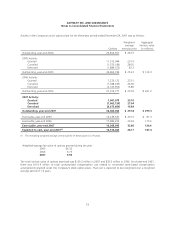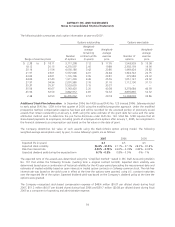Safeway 2007 Annual Report Download - page 66
Download and view the complete annual report
Please find page 66 of the 2007 Safeway annual report below. You can navigate through the pages in the report by either clicking on the pages listed below, or by using the keyword search tool below to find specific information within the annual report.
SAFEWAY INC. AND SUBSIDIARIES
Notes to Consolidated Financial Statements
funded status of a defined benefit postretirement plan in the year in which the changes occur. Additional disclosures are
also required. Safeway adopted SFAS No. 158 as of December 30, 2006, as required. See Note I.
Self-Insurance The Company is primarily self-insured for workers’ compensation, automobile and general liability costs.
The self-insurance liability is determined actuarially, based on claims filed and an estimate of claims incurred but not yet
reported, and is discounted using a risk-free rate of interest. The present value of such claims was calculated using a
discount rate of 3.5% in 2007, 4.5% in 2006 and 4.35% in 2005.
A summary of changes in Safeway’s self-insurance liability is as follows (in millions):
2007 2006 2005
Beginning balance $ 512.7 $ 532.4 $ 496.5
Expense 117.1 133.2 193.7
Claim payments (153.2) (152.9) (157.8)
Currency translation loss 1.0 ––
Ending balance 477.6 512.7 532.4
Less current portion (130.2) (138.7) (144.2)
Long-term portion $ 347.4 $ 374.0 $ 388.2
The current portion of the self-insurance liability is included in other accrued liabilities, and the long-term portion is
included in accrued claims and other liabilities in the consolidated balance sheets. The total undiscounted liability was
$564.5 million at year-end 2007 and $618.5 million at year-end 2006.
Deferred Rent
Rent Escalations. The Company recognizes escalating rent provisions on a straight-line basis over the lease term.
Rent Holidays. Certain of the Company’s operating leases contain rent holidays. For these leases, Safeway recognizes
the related rent expense on a straight-line basis at the earlier of the first rent payment or the date of possession of the
leased property. The difference between the amounts charged to expense and the rent paid is recorded as deferred lease
incentives and amortized over the lease term.
Construction Allowances. As part of certain lease agreements, the Company receives construction allowances from
landlords. The construction allowances are deferred and amortized on a straight-line basis over the life of the lease as a
reduction to rent expense.
Income Taxes The Company provides income tax expense or benefit in accordance with Statement of Financial
Accounting Standards (“SFAS”) No. 109, “Accounting for Income Taxes.” Deferred income taxes represent future net tax
effects resulting from temporary differences between the financial statement and tax basis of assets and liabilities using
enacted tax rates in effect for the year in which the differences are expected to reverse. Accrued interest on tax
deficiencies and refunds is included in the income tax expense or benefit.
In June 2006, the Financial Accounting Standards Board (“FASB”) issued FASB Interpretation No. 48, “Accounting for
Uncertainty in Income Taxes—an interpretation of FASB Statement No. 109” (“FIN 48”) which was effective for Safeway
in the first quarter of 2007. FIN 48 prescribes a recognition threshold and measurement attribute for the financial
statement recognition and measurement of tax positions taken or expected to be taken in tax returns. For benefits to be
realized, a tax position must be more likely than not to be sustained upon examination. The amount recognized is
measured as the largest amount of benefit that is more likely than not of being realized upon settlement.
Income Tax Contingencies The Company is subject to periodic audits by the Internal Revenue Service and other
foreign, state and local taxing authorities. These audits may challenge certain of the Company’s tax positions such as the
timing and amount of income and deductions and the allocation of taxable income to various tax jurisdictions. Income tax
contingencies are accounted for in accordance with FIN 48, and may require significant management judgment in
44








